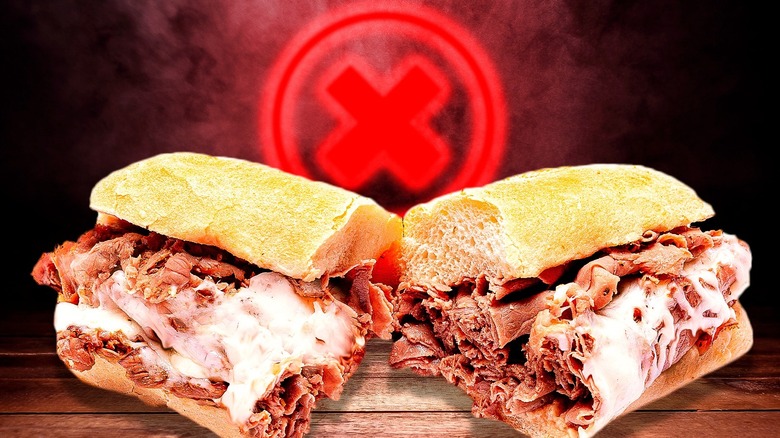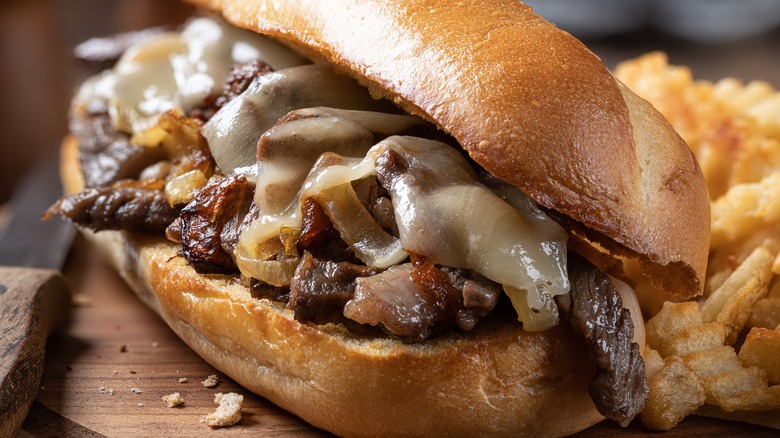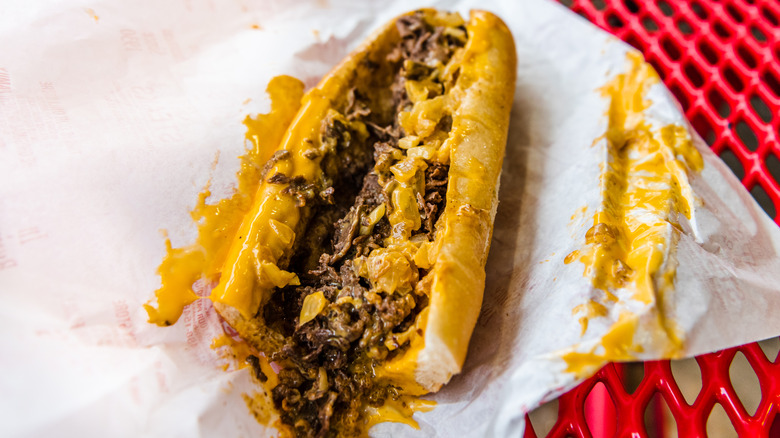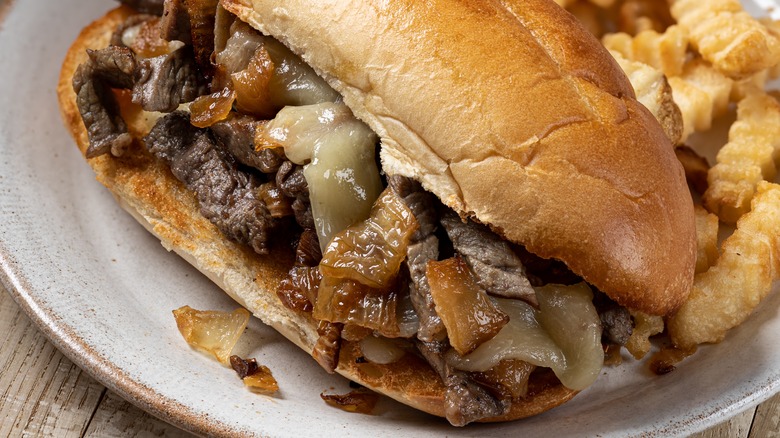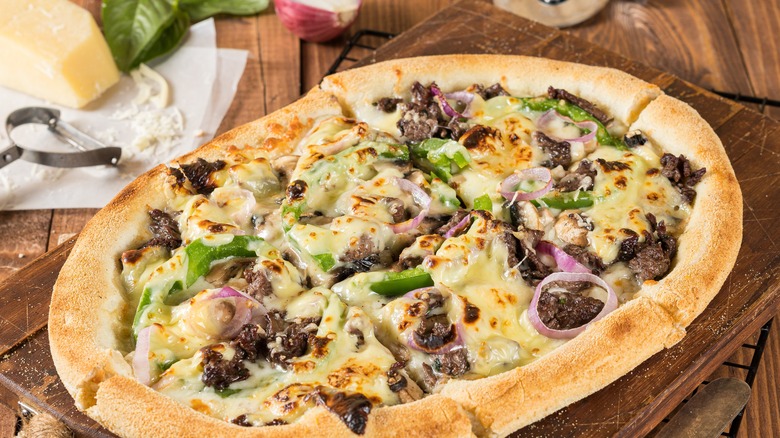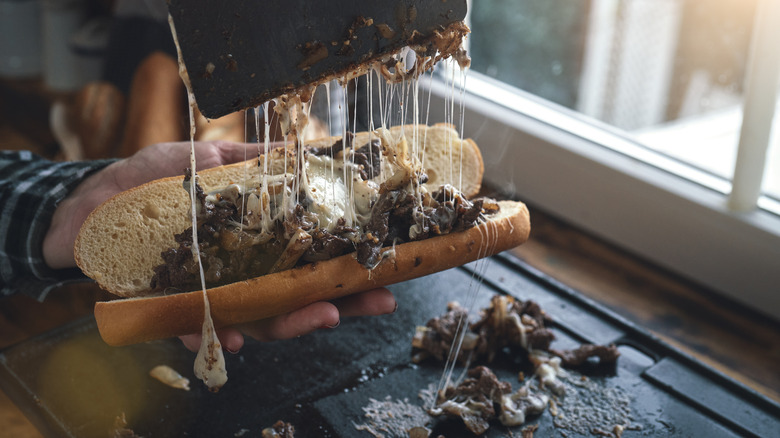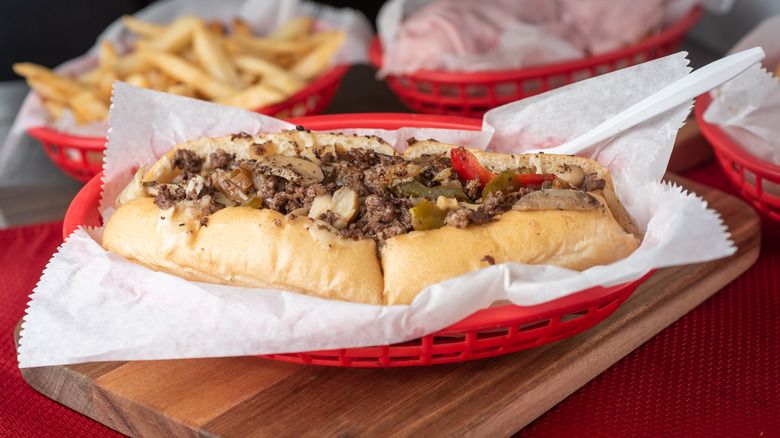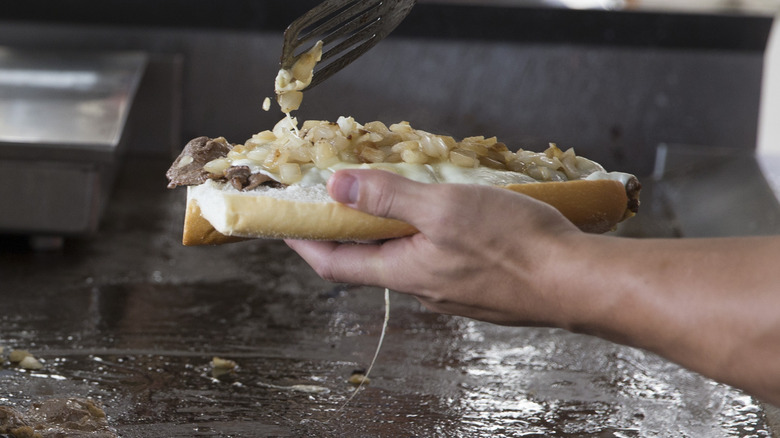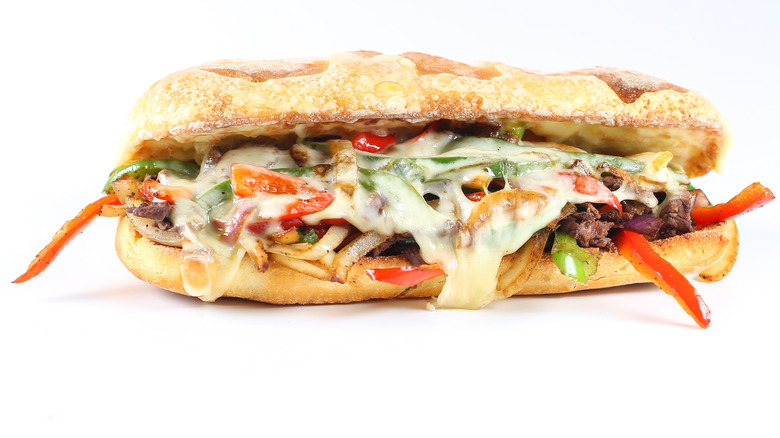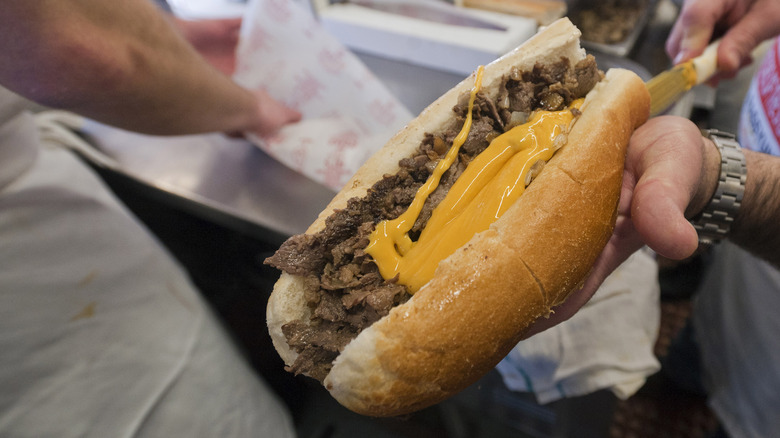11 Mistakes Everyone Makes With Philly Cheesesteaks
Anyone who has had the pleasure of visiting the great city of Philadelphia, Pennsylvania, probably (hopefully) took a moment to indulge in one of the best sandwiches known to man: the Philly cheesesteak sandwich. For those still waiting to bite into one of the world's greatest mouthfuls, imagine all the juiciness of a French dip as it comes out of a killer consommé, combined with delicious caramelized onions strewn throughout every inch of the generously overspilling Philly cheesesteak filling, plus the promise of perfectly paired cheese enveloping every little morsel, all cooked together and tossed into the welcoming embrace of a fresh-baked bread roll ... To put it in one word: "Yum."
Lucky for you, me, and anyone else who loves to eat, preparing this quintessential East Coast steak-based sandwich is actually kind of easy ... at least if you follow a good Philly cheesesteak recipe, and if you know what mistakes everyone makes with Philly cheesesteaks. So, read on if you want to learn how to avoid the most common Philly cheese-mis-steaks. And once you learn that the best Philly cheesesteaks need not be bought from the top Philly cheesesteak restaurants but can be whipped up in the kitchen instead, you may realize that the biggest Philly cheesesteak mistake is not making them at home (at least until now).
Using the wrong cut of beef
A Philly cheesesteak requires as few as four ingredients: bread, onion, cheese, and (of course) meat. As a sandwich of such simplicity, the Philly cheesesteak relies on the sum of its parts, on those ingredients being treated with respect and cooked by someone who understands the who, what, when, where, and why behind the steak that elevates this sandwich to greatness. This means nailing not only the Philadelphia part of it, because culture can shine through (or be lacking) in a recipe ... but assembling an astonishingly good Philly cheesesteak at home also means ensuring that you use top-notch steak.
What does top-notch steak look like in the case of a Philly cheesesteak? Well, it should be a flavorful cut o' cattle, full of fat and juice and all those good things, but not a steak so fancy that someone would object to slicing it thin, smothering it in cheese, and slamming it down all together on a roll. In other words, the biggest "misteak" you can make in cooking an authentic Philly cheesesteak is not grabbing a ribeye, the authentic Philly cheesesteak steak of choice. Bottom line: don't choose a different cut for your homemade rendition of this famous sandwich recipe.
Choosing a thick steak rather than thin
The urge to go after a thick steak when you want to make a top-rate Philly cheesesteak sandwich is entirely understandable. After all, a perfectly medium rare cook on a thick-cut steak will, nine times out of 10, win out against thin-cut steak. But as with every rule, both in the kitchen and outside of it, there are exceptions; and the Philly cheesesteak is one such exception, a standout sandwich that calls for thinly sliced steak rather than a thick steak. And no, you can't just cook a 2-inch tall filet and slice it thin afterward if you're looking for an authentic-tasting Philly cheesesteak rather than a(n admittedly delicious) simple steak sandwich of the non-Philly variety.
So, to avoid one of the most commonly made Philly cheesesteak mistakes, skip the thick-cut steak in lieu of a thin, almost shaved-down ribeye, the cut of beef that most authentic cheesesteak connoisseurs will agree is the best cut of choice.
Here's why this thin- versus thick-cut steak decision is such an important mistake not to make with your Philly cheesesteak: This sandwich's ultimate appeal is all about retaining the juice and flavor in the fillings rather than on the pan. And keep in mind that there won't be a whole lot of crispiness in this dish, so aim for flavor retention by slow-cooking thin slices and holding on to the fat and flavor rather than trying to elicit any sort of Maillard reaction.
Losing the meat's juice
An exceptionally common faux pas people make when it comes to perfecting a homemade Philly cheesesteak is expecting it to retain that famous juicy quality without putting in the work to keep that sandwich just as juicy as any sold in Philadelphia. But how do the finest Philly cheesesteak makers retain that juicy quality? Well, the decision to select a ribeye steak versus other cuts cattle is incredibly important since ribeye is high in fat and flavor, and can sear low n' slow to juicy, tender perfection much better than other popular cuts such as the filet, New York strip, or T-bone.
To avoid the mistake of serving up a dry Philly cheesesteak, remember these three key things: use thin-sliced ribeye, cook everything at a low temperature for longer than you would a quickly seared steak, and don't salt the steak before you're ready to top it with cheese and serve it up. This is because salt draws moisture out of ingredients (steaks included), and if you salt the thin-sliced ribeye at the beginning of the cooking process, you will end up with all that delicious juiciness evaporating into the sky rather than enveloping your taste buds with every bite.
Not slicing the onions thin enough
Onions are one of the most versatile of ingredients, which means that knowing how to treat them is vital to the dish at hand turning out as its best self. The Philly cheesesteak is, again, a sandwich of few ingredients, which means it calls for a high degree of technical know-how to make each and every ingredient shine. And one of the biggest mistakes people can make when it comes to homemade Philly cheesesteak is in the onions ... specifically, in cutting the onions too thick for this particular sandwich.
There are a whole lot of onion mistakes you can make with Philly cheesesteak, but not slicing them thin enough is among the most egregious. First, a thinly sliced onion will cook quickly enough to keep up with the pace of what should be a street-food level speedy sandwich and, if the onions are too thick, they won't cook in time for the rest of the meal to still be hot. And really, with a Philly cheesesteak sandwich, you want the onions sliced so thin that they practically melt into themselves and the steak and become almost a sauce that binds all those meaty flavors together. So, if those onions aren't practically caramelizing and then disintegrating as fast as you'd expect, consider cutting them even thinner on the next go-around for homemade Philly cheesesteaks.
Not getting creative with it
I was in a popular sandwich shop once when a customer came up behind me and asked for an order I'll never forget. He said, "I want a sandwich, but make it exactly like a pepperoni pizza." It was such a clear order but somehow crossed so many boundaries of what a sandwich is or should be. Bbut he didn't care, and after hearing his blasé order that refuted all sandwich rules, I found that I somehow (quite suddenly) didn't care either. The next time I went back to that sandwich shop, I ordered the same thing he did and it was magnificent.
The same idea applies to the homemade Philly cheesesteak, which can only be ordered authentically but can be made within the confines of your own home and kitchen to the exact specifications you desire, no matter how off the wall they may be. This means your homemade Philly cheesesteak may be transformed (hypothetically speaking) into anything your imagination might conceive: Philly cheesesteak pizza, Philly cheesesteak ramen, a grilled cheese sandwich but make it a Philly cheesesteak, Philly cheesesteak as a topping for onion rings, as a part of a Philly cheesesteak poutine ... The list goes on and on for what is essentially eternity. And if you're feeling Philly cheesesteak creative but not down to brainstorm, consider these recipe hacks for Philly cheesesteak.
Automatically adding bell peppers
Bell peppers have, over time, somehow managed to make themselves an associated staple when it comes to the image many people have of a Philly cheesesteak, but the truth is that most authentic Philadelphia cheesesteak sandwiches do not include bell peppers. In fact, some would say it is a mistake of the highest order to add bell peppers, especially when you're doing it because you think the recipe calls for bell peppers (as opposed to purposefully deciding to add them because that is your personal preference).
So, if you're planning to make Philly cheesesteaks and want to avoid the most common mistakes, leave the bell peppers off. And after you've nailed the most authentic Philly cheesesteak sandwich recipe, then adding things like bell peppers, jalapeños, different kinds of cheeses, elements from other cultural dishes, or any Philly cheesesteak alteration you please will be that much easier. Whatever kind of creativity this sandwich inspires, just be sure to nail the original concept first (for best results, that is).
Skimping on the melty cheese
Now it is time to talk about the best cheese to use in your homemade Philly cheesesteak recipe — and, quite imperatively, save you from the common error of not knowing which cheeses to avoid and which to use if you seek to make an authentic Philly cheesesteak sandwich.
Here are the three cheeses best for a homemade Philly cheesesteak: provolone, American, Cheez Whiz, or any combination thereof. Provolone offers that extra pull factor and a very neutral flavor that won't get in the way of all that steak-y goodness going on in every bite. American cheese, on the other hand, is a terrific topping for any Philly cheesesteak as it has an incredibly creamy, perfectly melty texture that allows for all those flavors to meld and melt together into one delicious sandwich. And as for the Cheez Whiz ... well, it's hard to beat that classically cheesy, practically dissolve-on-your-tongue experience.
Not letting all the flavors meld before serving
This often-missed step of letting the flavors meld on the griddle before serving on a bun is the magic touch that turns a simple steak sandwich into that widely beloved Philly cheesesteak It is also the unspoken step that separates a lot of homemade Philly cheesesteak sandwich attempts from the professional cheesesteaks you can taste all across Philadelphia.
Though letting ingredients sit is often the most underrated step in recipes and cooking, absolutely no one should skip out on allowing a beat in the cooking process for all those various and tasty flavors of meat, onions, seasonings, and cheese to attain a certain je ne sais quoi when combined on a hot griddle. When you have that first bite of everything together (versus barely thrown together with the cheese just melted by less than a minute), you'll know the difference patience can make for a genuine Philly cheesesteak experience.
Toasting the bread roll
An unexpected mistake most people make when setting out to recreate a Philly cheesesteak in the comfort of their kitchen is toasting the roll. Although a toasted bun is almost always a good idea, there is something about this specific sandwich that calls for skipping the toasted bun and instead using an entirely un-toasted roll with no crispiness to speak of. In other words, an authentic Philly cheesesteak is typically served without a toasted bun, so your homemade rendition should aim for the same non-toastedness.
But you may be wondering, why is it a mistake to toast my bread for this sandwich? Isn't it a matter of personal preference? To an extent ... yes, toasted buns are a simple extension of preference but they also serve a higher purpose: mopping up all the amazing juice and steak sauce that'll be dripping out of that meat as soon as it hits its bread-y receptacle. While toasted bread lets the juices slip through, dribble away, and escape, un-toasted bread enables your Philly cheesesteak to retain all the fat, juice, and flavor within the bun itself.
Not adding condiments like mayo/mustard (if desired)
It is safe to assume that Philly cheesesteak purists will absolutely disagree with me on this one, but hear me out. If you wish to add a touch of mustard or a dash of mayo (or anything else, really) to your homemade Philly cheesesteak sandwich, that is well within your rights as the maker of said sandwich. The best part of crafting homemade renditions of popular dishes is knowing that, no matter how you like to dress them up, it is entirely up to the individual tastes of the person wielding the spatula.
No amount of authenticity is worth forgoing that one flavor that your cravings and palate are saying will boost this sandwich. And what's the worst that can happen if worse comes to worst and the combo just doesn't gel? Well, you get a slightly less amazing Philly cheesesteak this time around and learn a valuable lesson for next time ... which doesn't sound all that bad, come to think of it! So, use your imagination and don't be afraid to see what kind of condiments you can use to soup up that Philly cheesesteak creation. Who knows, you may invent the next best dish since the Korean Philly cheesesteak fusion.
Forgetting the napkins
If you've avoided all the key mistakes up until this point, then your homemade Philly cheesesteak sandwich should be a delicious, wet, cheesy, meaty mess ... exactly as you'd hoped! And if there's tasty stuff oozing out of every side of your sandwich, enjoy every bite knowing that you've successfully made a Philadelphia market-worthy cheesesteak. This also means that you need enough napkins to compensate for that ensuing cheese overload and meat juice excess.
And if you're the kind of person who is all about cloth napkins and sustainability, that's awesome! Just be sure you bring more of a kitchen towel kind of napkin to this homemade sandwich experience rather than those decorative pieces without a whole lot of absorption power. After all, a good Philly cheesesteak sandwich will surely drip ... and a napkin is essential for whatever delicious Philly cheesesteak drippings your tongue and teeth can't quite catch.
